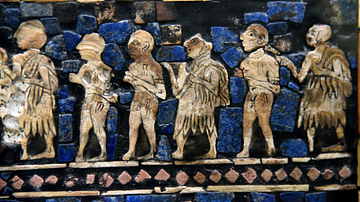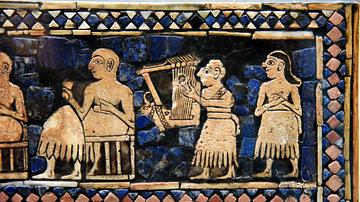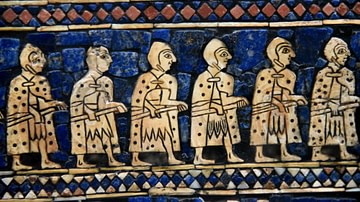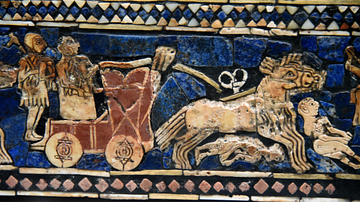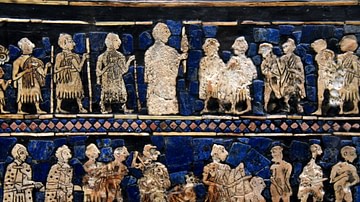Illustration
This is a close-up view of the so-called "Peace Scene" of the Standard of Ur. The scene is composed of three horizontal registers, showing a feast or a banquet. The central figure of the scene appears on the top register, and is depicted larger than others; this is probably a king. He sits on a chair, holds a cup, and faces right. Some of the participants sit on their chair and hold a cup in their right hand. In the middle register, men, wearing flounced kilts or skirts, parade various animals. One man holds 4 fishes in his hands. In the bottom register, men dressed differently (from the those of the above registers) hold goods in backpacks and bags. An equid appears in the middle and part of the hind part of another equid appears on the right margin. The depictions, in mosaic, were made using lapis lazuli, red limestone, and shell set in place with bitumen. The Standard of Ur is a (reconstructed) hollow box and its precise purpose is unknown. Early Dynastic Period, circa 2500 BCE. From the Royal Cemetry of Ur, Ur, Sothern Mesopotamia, modern-day Iraq. (The British Museum, London).
About the Author
Cite This Work
APA Style
Amin, O. S. M. (2018, April 14). Peace Scene of the Standard of Ur. World History Encyclopedia. Retrieved from https://www.worldhistory.org/image/8421/peace-scene-of-the-standard-of-ur/
Chicago Style
Amin, Osama Shukir Muhammed. "Peace Scene of the Standard of Ur." World History Encyclopedia. Last modified April 14, 2018. https://www.worldhistory.org/image/8421/peace-scene-of-the-standard-of-ur/.
MLA Style
Amin, Osama Shukir Muhammed. "Peace Scene of the Standard of Ur." World History Encyclopedia. World History Encyclopedia, 14 Apr 2018, https://www.worldhistory.org/image/8421/peace-scene-of-the-standard-of-ur/. Web. 16 Apr 2025.



